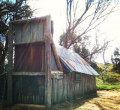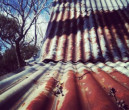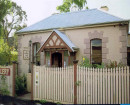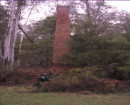WALLACES HUT
WALLACES TRACK NELSE, EAST GIPPSLAND SHIRE
-
Add to tour
You must log in to do that.
-
Share
-
Shortlist place
You must log in to do that.
- Download report


Statement of Significance
Wallaces hut was built in 1889 and is probably the oldest surviving hut on the high plains of north-east Victoria. It was built in six weeks by Irish immigrant brothers Arthur, William and Stewart Wallace among old snow gums on a grassy plain above the snowline. The brothers held grazing leases on the High Plains, and the hut was built to provide shelter for the cattlemen working there. The timber was cut from the forest about four hundred metres east of the hut, and the hearth stone was dragged in from Pretty Valley. The chimney had a base of rubble and above this iron sheeting on a timber frame. The slab walls were lined with hessian and later with tar-paper, and inside there was a bush table, sleeping platform and a rustic fire-side settle. The hut was used by many local cattlemen, as well as stockmen from New South Wales, who brought sheep here during the 1914-18 drought. Many such huts were built in mountain areas, but they were flimsy structures, and at great risk from bush fires, and no others have survived from the nineteenth century. The State Electricity Commission used the hut from the late 1920s until the early 1940s to collect data on precipitation for possible future hydroelectric works, and SEC employee Joe Holsten covered the roof and later the walls with corrugated iron, renewed the chimney and added a skillion for storing firewood and horse feed. In the 1940s the Rover section of the Boy Scout Association took over responsibility for maintenance, and it became an important refuge and destination for walkers and skiers.
Wallaces Hut is of historical and architectural significance to the State of Victoria.
Wallaces Hut is historically significant for its long link with the Victorian High Plains cattlemen, reflected in its siting, construction, materials and form. It is probably the oldest hut on the Victorian high plains. It is also significant for its links with early SEC meteorological data recording in the area and the early history of hydroelectricity in the state.
[Online Data Upgrade Project - 2004]
-
-
WALLACES HUT - History
Wallaces’ hut was built in 1889 and is probably the oldest surviving hut on the high plains of north-east Victoria. It was built in six weeks by Irish immigrant brothers Arthur, William and Stewart Wallace among old snow gums on a grassy plain above the snowline. The brothers held grazing leases on the High Plains, and the hut was built to provide shelter for the cattlemen working there. The timber was cut from the forest about four hundred metres east of the hut, and the hearth stone was dragged in from Pretty Valley. The chimney had a base of rubble and above this iron sheeting on a timber frame. The slab walls were lined with hessian and later with tar-paper, and inside there was a bush table, sleeping platform and a rustic fire-side settle. The hut was used by many local cattlemen, as well as stockmen from New South Wales, who brought sheep here during the 1914-18 drought. Many such huts were built in mountain areas, but they were flimsy structures, and at great risk from bush fires, and no others have survived from the nineteenth century. The State Electricity Commission used the hut from the late 1920s until the early 1940s to collect data on precipitation for possible future hydroelectric works, and SEC employee Joe Holsten covered the roof and later the walls with corrugated iron, renewed the chimney and added a skillion for storing firewood and horse feed. In the 1940s the Rover section of the Boy Scout Association took over responsibility for maintenance, and it became an important refuge and destination for walkers and skiers.
The draft statement of significance and the above history were produced as part of an Online Data Upgrade Project 2003. Sources used were as follows:
Graeme Butler & Associates, ‘Victorian Alpine Huts Heritage Survey’, 1996.
Harry Stephenson, Cattlemen & Huts of the High Plains, Melbourne 1980.
Fiona Magnussen, Victoria’s Alpine Heritage, Henty [NSW] 2003.
Klaus Hueneke, Huts in the Victorian Alps, Palmerston [ACT] 2003.WALLACES HUT - Permit Exemptions
General Exemptions:General exemptions apply to all places and objects included in the Victorian Heritage Register (VHR). General exemptions have been designed to allow everyday activities, maintenance and changes to your property, which don’t harm its cultural heritage significance, to proceed without the need to obtain approvals under the Heritage Act 2017.Places of worship: In some circumstances, you can alter a place of worship to accommodate religious practices without a permit, but you must notify the Executive Director of Heritage Victoria before you start the works or activities at least 20 business days before the works or activities are to commence.Subdivision/consolidation: Permit exemptions exist for some subdivisions and consolidations. If the subdivision or consolidation is in accordance with a planning permit granted under Part 4 of the Planning and Environment Act 1987 and the application for the planning permit was referred to the Executive Director of Heritage Victoria as a determining referral authority, a permit is not required.Specific exemptions may also apply to your registered place or object. If applicable, these are listed below. Specific exemptions are tailored to the conservation and management needs of an individual registered place or object and set out works and activities that are exempt from the requirements of a permit. Specific exemptions prevail if they conflict with general exemptions. Find out more about heritage permit exemptions here.Specific Exemptions:General Conditions: 1. All exempted alterations are to be planned and carried out in a manner which prevents damage to the fabric of the registered place or object. General Conditions: 2. Should it become apparent during further inspection or the carrying out of works that original or previously hidden or inaccessible details of the place or object are revealed which relate to the significance of the place or object, then the exemption covering such works shall cease and Heritage Victoria shall be notified as soon as possible. Note: All archaeological places have the potential to contain significant sub-surface artefacts and other remains. In most cases it will be necessary to obtain approval from the Executive Director, Heritage Victoria before the undertaking any works that have a significant sub-surface component.General Conditions: 3. If there is a conservation policy and plan all works shall be in accordance with it. Note:A Conservation Management Plan or a Heritage Action Plan provides guidance for the management of the heritage values associated with the site. It may not be necessary to obtain a heritage permit for certain works specified in the management plan.
General Conditions: 4. Nothing in this determination prevents the Executive Director from amending or rescinding all or any of the permit exemptions. General Conditions: 5. Nothing in this determination exempts owners or their agents from the responsibility to seek relevant planning or building permits from the responsible authorities where applicable. Minor Works : Note: Any Minor Works that in the opinion of the Executive Director will not adversely affect the heritage significance of the place may be exempt from the permit requirements of the Heritage Act. A person proposing to undertake minor works must submit a proposal to the Executive Director. If the Executive Director is satisfied that the proposed works will not adversely affect the heritage values of the site, the applicant may be exempted from the requirement to obtain a heritage permit. If an applicant is uncertain whether a heritage permit is required, it is recommended that the permits co-ordinator be contacted.
-
-
-
-
-
WALLACES HUT
 Victorian Heritage Register H1616
Victorian Heritage Register H1616
-
'Lawn House' (Former)
 Hobsons Bay City
Hobsons Bay City -
1 Fairchild Street
 Yarra City
Yarra City -
10 Richardson Street
 Yarra City
Yarra City
-
-
Notes See all notes
17/11/14
Easy 750m walk from the car park, currently undergoing restoration so no access inside the hut.
Public contributions
Notes See all notes
17/11/14
Easy 750m walk from the car park, currently undergoing restoration so no access inside the hut.












